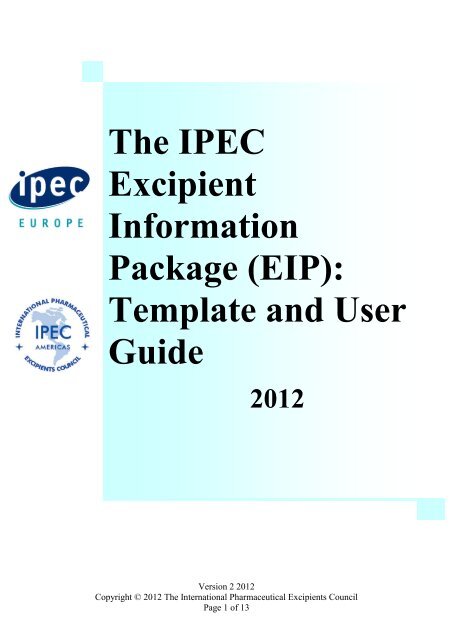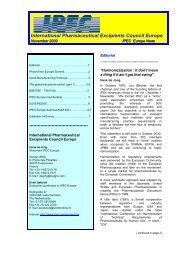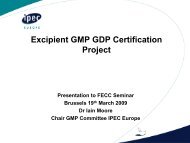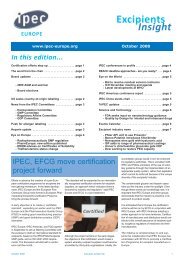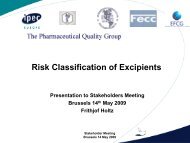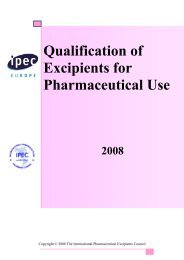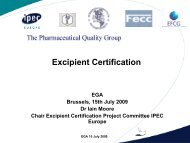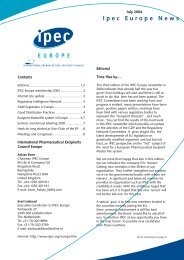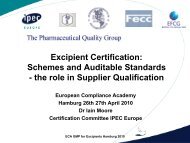Download PDF format - IPEC Europe
Download PDF format - IPEC Europe
Download PDF format - IPEC Europe
You also want an ePaper? Increase the reach of your titles
YUMPU automatically turns print PDFs into web optimized ePapers that Google loves.
The <strong>IPEC</strong><br />
Excipient<br />
In<strong>format</strong>ion<br />
Package (EIP):<br />
Template and User<br />
Guide<br />
2012<br />
Version 2 2012<br />
Copyright © 2012 The International Pharmaceutical Excipients Council<br />
Page 1 of 13
FOREWORD<br />
<strong>IPEC</strong> is an international industry association formed in 1991 by manufacturers and end-users<br />
of excipients. It is an association comprising four regional pharmaceutical excipient industry<br />
associations covering North America, <strong>Europe</strong>, China and Japan (which are known<br />
respectively as <strong>IPEC</strong>-Americas, <strong>IPEC</strong> <strong>Europe</strong>, <strong>IPEC</strong>-China and JPEC). <strong>IPEC</strong>’s objective is to<br />
contribute to the development and harmonization of international excipient standards, the<br />
introduction of useful new excipients to the marketplace and the development of best practice<br />
and guidance concerning excipients.<br />
<strong>IPEC</strong> has three major stakeholder groups;<br />
1. Excipient manufacturers and distributors, who are called suppliers<br />
2. Pharmaceutical manufacturers, who are called users<br />
3. Regulatory authorities who regulate medicines<br />
Suppliers<br />
<strong>IPEC</strong><br />
Users<br />
Regulatory<br />
Authorities<br />
This document offers best practice and guidance in the establishment of an excipient<br />
in<strong>format</strong>ion package. The excipient supplier may be a manufacturer or a distributor (or both).<br />
The Guide highlights the factors to consider when preparing such a package.<br />
Version 2 2012<br />
Copyright © 2012 The International Pharmaceutical Excipients Council<br />
Page 2 of 13
ACKNOWLEDGEMENTS<br />
This guideline is the result of the hard work and substantial resources, of <strong>IPEC</strong> member<br />
companies. <strong>IPEC</strong> greatly appreciates the many hours the following individuals devoted to<br />
develop this guide and the generous support of their employers for providing the necessary<br />
time and resources.<br />
<strong>IPEC</strong>-AMERICAS<br />
Alexa Smith, Colorcon<br />
Priscilla Zawislak, Ashland Chemicals<br />
David B. Klug, Sanofi U.S.<br />
Londa Ritchey, Wyeth<br />
Ann Van Meter, Dow<br />
Cindy Libonati, Purdue Pharma L.P.<br />
William Fersch, Purdue Pharma L.P.<br />
Maurice Biagini, Avantor Materials<br />
<strong>IPEC</strong> EUROPE<br />
Kevin McGlue, Colorcon Limited<br />
Carl Mroz, Colorcon Limited<br />
Rebecca Teversham, Colorcon Limited<br />
Version 2 2012<br />
Copyright © 2012 The International Pharmaceutical Excipients Council<br />
Page 3 of 13
INTRODUCTION<br />
SCOPE AND PURPOSE<br />
In order to use an excipient, users need to obtain a significant amount of data about the<br />
excipient manufacturer, distributor, where applicable, and the excipient itself. Many users<br />
have resorted to sending questionnaires and surveys to obtain this in<strong>format</strong>ion using their<br />
own individual <strong>format</strong>s. Often these surveys and questionnaires address essentially the same<br />
quality and regulatory concerns. It is also difficult in some cases, due to the phrasing of<br />
specific questions, to interpret the intent of the question.<br />
While excipient suppliers want to provide in<strong>format</strong>ion to the user as quickly as possible,<br />
many excipient suppliers receive such a large volume of questionnaires and surveys from<br />
their customers that they are unable, due to resource constraints, to individually complete<br />
each customer’s specific form. Further, because these surveys and questionnaires vary to<br />
some degree in the specific questions asked, if a change in the in<strong>format</strong>ion occurs, it is not<br />
feasible for the excipient supplier to determine which completed surveys and questionnaires<br />
are affected by the change. Significant time and resources are spent, both by the user and<br />
supplier, to send, complete, return, review and track these non-standardized questionnaires<br />
and surveys.<br />
This guide was developed in order to address these issues. It defines the Standardized<br />
Excipient In<strong>format</strong>ion Package that comprises:<br />
Product Regulatory Datasheet<br />
Site Quality Overview<br />
Site And Supply Chain Security Overview<br />
The primary goal of the template is to provide standards for the exchange of data between<br />
excipient suppliers and users that will simplify this process. By responding to surveys,<br />
questionnaires and other requests for in<strong>format</strong>ion in this <strong>format</strong>, excipient suppliers can<br />
respond in a timely and efficient manner to all requests as well as ensure that consistent<br />
in<strong>format</strong>ion is provided. Excipient users will be able to anticipate the type and <strong>format</strong> of the<br />
standard data that they receive from excipient suppliers. This will assist both users and<br />
suppliers in the management of such in<strong>format</strong>ion. In the future, electronic transmission of this<br />
data for direct download may be possible. Additionally, this standardization will facilitate any<br />
necessary change notifications pertaining to previously supplied in<strong>format</strong>ion further<br />
strengthening the excipient suppliers’ change notification program.<br />
FORMAT OF THE EXCIPIENT INFORMATION PACKAGE DOCUMENTS<br />
The Excipient In<strong>format</strong>ion Package (EIP) is set up much like a Material Safety Data Sheet<br />
(MSDS) with designated sections to include specified data. Each section covers specific<br />
topics. The minimum topics that should be covered in each section are defined, however,<br />
additional related in<strong>format</strong>ion can also be provided at the discretion of the excipient supplier.<br />
If particular topics are not applicable to a particular excipient or site, it should be so indicated<br />
in the document. Where in<strong>format</strong>ion is considered confidential, the document should reflect<br />
how the excipient user can obtain this in<strong>format</strong>ion. For example, the document may state that<br />
the in<strong>format</strong>ion may only be obtained under a confidentiality agreement.<br />
Version 2 2011<br />
Copyright © 2011 The International Pharmaceutical Excipients Council<br />
Page 4 of 13
The presentation and <strong>format</strong> of the in<strong>format</strong>ion is at the discretion of the supplier. Short,<br />
bulleted <strong>format</strong>s are encouraged. Specific phrasing is not prescribed but suggested phrasing is<br />
provided in some sections and can be used if desired. Job titles should be used rather than<br />
names.<br />
These documents should be version controlled by the excipient supplier. Suppliers should<br />
have a process in association with their management of change policy for updating EIP<br />
documents in a timely manner including updates to company and product in<strong>format</strong>ion and<br />
EIP template revisions. The current version of the EIP template can be found on the regional<br />
<strong>IPEC</strong> websites.<br />
The documents do not require signatures, however they must be an official company<br />
document.<br />
APPLICATION AND USAGE<br />
The EIP documents are intended for individuals experienced and competent in the area of<br />
evaluating excipient suppliers and should not be viewed as a replacement for audits. While<br />
the documents are intended to form a complete package of in<strong>format</strong>ion, each document<br />
within the EIP was designed to also be functional as a stand-alone document and therefore,<br />
some basic in<strong>format</strong>ion may be common among the documents.<br />
In order to provide additional guidance on specific topics, <strong>IPEC</strong>-Americas maintains a<br />
Regulatory Reference Guide. The Regulatory Reference Guide lists links to the specific<br />
regulatory references applicable in different regions to various sections in the EIP documents.<br />
These references can provide preparers of EIP documents detailed guidance on the<br />
in<strong>format</strong>ion that needs to be addressed in various sections. <strong>IPEC</strong>-Americas’s Regulatory<br />
Reference Guide is accessible through the <strong>IPEC</strong>-Americas website at the following address:<br />
www.ipecamericas.org.<br />
Version 2 2012<br />
Copyright © 2012 The International Pharmaceutical Excipients Council<br />
Page 5 of 13
SECTION BY SECTION EVALUATION OF THE EXCIPIENT INFORMATION<br />
DOCUMENTS<br />
I. Product Regulatory Datasheet<br />
The Product Regulatory Datasheet is designed as a means to assist in communicating to<br />
the user important physical, manufacturing and regulatory in<strong>format</strong>ion specific to the<br />
excipient. This in<strong>format</strong>ion is intended to facilitate the use of the excipient in drug<br />
products. Not every point is necessarily applicable to each excipient.<br />
The following sections are expected to be included in the document unless otherwise<br />
specified.<br />
Section 1 – General Product In<strong>format</strong>ion<br />
This section provides identification in<strong>format</strong>ion for the product .<br />
Topics for this section:<br />
Product name/code<br />
Scope of document<br />
Other general product in<strong>format</strong>ion (optional)<br />
Section 2 – Manufacturing, Packaging, Release Site and Supplier In<strong>format</strong>ion<br />
This section provides general in<strong>format</strong>ion about where the product is manufactured<br />
and other supply chain in<strong>format</strong>ion. It includes cross references to the Site Quality<br />
Overview and Site and Supply Chain Security Overview, where applicable.<br />
Topics for this section:<br />
Sites of manufacturing, processing, packaging, product release<br />
and other related sites such as warehousing, terminals, contract<br />
labs, etc.<br />
Exclusive distribution channels (if applicable)<br />
GMP or GDP compliance statement, as applicable<br />
Multi purpose / dedicated equipment<br />
Section 3 – Physico-chemical In<strong>format</strong>ion<br />
This section provides general in<strong>format</strong>ion about the chemistry and physical<br />
characteristics of the product and its manufacture.<br />
Topics for this section:<br />
CAS number<br />
Origin in<strong>format</strong>ion (synthetic, animal, vegetable, mineral,<br />
product of biotechnology, product of fermentation, etc.)<br />
Synonyms (including INCI name if applicable) (Optional)<br />
Morphological form (Optional)<br />
Brief description of manufacture (blend, reaction, continuous /<br />
batch process etc.)<br />
Mixed excipient ingredient statement<br />
Country of origin for ingredients used in mixed excipients<br />
(optional)<br />
Version 2 2012<br />
Copyright © 2012 The International Pharmaceutical Excipients Council<br />
Page 6 of 13
Section 4 - Regulatory In<strong>format</strong>ion<br />
This section includes in<strong>format</strong>ion related to the regulatory status of the excipient as<br />
well as addressing pertinent product specific topics of general regulatory concern.<br />
Topics for this section:<br />
See Annex I for the type of in<strong>format</strong>ion which may be included<br />
in this section<br />
Section 5 - Miscellaneous Product In<strong>format</strong>ion<br />
This section should be used by the supplier to provide any additional in<strong>format</strong>ion that<br />
may be pertinent to the product but is not covered elsewhere in this document or in<br />
the other EIP documents.<br />
Topics for this section could include:<br />
Explanation of the lot/batch numbering system<br />
Batch definition statement<br />
Statement as to Expiration date and/or recommended reevaluation<br />
interval (see <strong>IPEC</strong> Stability guide)<br />
Specific storage and shipping conditions which are required to<br />
assure excipient quality<br />
Common uses (Optional)<br />
Nutritional in<strong>format</strong>ion (Optional)<br />
Packaging e.g. specification, size, types, new/recycled, bulk<br />
tankers, type of tamper evidence devices and labelling<br />
in<strong>format</strong>ion (Optional)<br />
Section 6 – Revisions<br />
This section provides in<strong>format</strong>ion related to version control for the document. The<br />
document should have a date and a version number. This section should also describe<br />
the changes made since the last revision.<br />
Section 7 - Contact In<strong>format</strong>ion<br />
This section explains how the user should contact the supplier to get additional<br />
in<strong>format</strong>ion, if needed, regarding the topics provided in this document.<br />
II. Site Quality Overview<br />
The Site Quality Overview is a tool to assist in evaluating the manufacturing practices<br />
and quality systems of suppliers, as well as a reference to inform users of the systems in<br />
place to assure appropriate GMP requirements. The “Joint <strong>IPEC</strong>-PQG Good<br />
Manufacturing Practice Guide for Pharmaceutical Excipients 2006" was used as the<br />
basis to construct this document and should serve as the primary source for evaluating<br />
responses provided by the supplier. Users of this document should be familiar with the<br />
introduction, definitions, and general guidance that are contained within the <strong>IPEC</strong>-PQG<br />
GMP Guide, and should refer to the guide if further details are needed.<br />
The Site Quality Overview is intended to communicate a summary of the Quality<br />
Systems and GMP used to manufacture the excipient(s). It may not necessarily include<br />
all of the details included in the Quality Manual, or covered in an audit, nor are all of<br />
the points necessarily appropriate to every site.<br />
Version 2 2012<br />
Copyright © 2012 The International Pharmaceutical Excipients Council<br />
Page 7 of 13
The following sections are expected to be included in the document unless otherwise<br />
specified.<br />
Section 1 - Site Overview<br />
The purpose of this section is to describe the supplier’s organization and production<br />
capabilities.<br />
Topics for this section:<br />
Scope<br />
Site Name(s)<br />
Address(es)<br />
Excipients covered by this document (optional)<br />
Corporate ownership (if different from site identified in Scope)<br />
Customer audit policy (optional)<br />
Site Details<br />
General Site In<strong>format</strong>ion (e.g. size, history, number of<br />
employees, shift operations, site plan, union workforce<br />
(optional), etc)<br />
Site activities conducted (e.g. blending, packaging, testing,<br />
R&D)<br />
Primary applications of products produced at this site<br />
(pharmaceutical, food, cosmetic, etc)<br />
Facility production of antibiotics, steroids, or hormone<br />
products<br />
Organizational chart (including responsibility for product<br />
release)<br />
Use scope and control of sub-contractors, if applicable<br />
Section 2 - Compliance Evidence<br />
This section should be used to describe any specific compliance in<strong>format</strong>ion pertinent<br />
to the facility being described.<br />
Suggested examples of compliance in<strong>format</strong>ion:<br />
ISO registration in<strong>format</strong>ion e.g. 9001, 14001, OHSAS 18001, etc.<br />
(number, registrar, copies of certificates)<br />
GMP Inspections by Competent Authorities (Regulatory Agencies)<br />
including outcome<br />
General GMP statements<br />
Other certifications or external audit programs: IPEA, AIB, GMA-SAFE,<br />
BRC, etc.<br />
Section 3 – <strong>IPEC</strong>-PQG GMP Compliance Details:<br />
This section should be used to address how the supplier complies with each applicable<br />
element of the <strong>IPEC</strong>-PQG GMP Guide. Non-applicable elements should be noted as<br />
such. For more detail on the specific items that may be covered under each topic,<br />
please refer to the <strong>IPEC</strong>-PQG GMP Guide. Parenthetical references in the document<br />
template refer to sections in the <strong>IPEC</strong>-PQG GMP Guide. Additional reference<br />
in<strong>format</strong>ion can be found in the <strong>IPEC</strong>-PQG GMP Audit Guideline for Pharmaceutical<br />
Excipients.<br />
Version 2 2012<br />
Copyright © 2012 The International Pharmaceutical Excipients Council<br />
Page 8 of 13
Section 4 - Miscellaneous Site In<strong>format</strong>ion<br />
This section should be used by the supplier to provide any additional in<strong>format</strong>ion that<br />
may be pertinent to the site but is not covered elsewhere in this document or in the<br />
other EIP documents. This section is optional and should be used as needed.<br />
Suggested topics for this section:<br />
Risk management plans such as HACCP<br />
Statistical Process Control / Process Analytical Technology (PAT)<br />
Section 5 – Revisions<br />
This section provides in<strong>format</strong>ion related to version control for the document. The<br />
document should have a date and a version number. This section should also describe<br />
the changes made since the last revision.<br />
Section 6 - Contact In<strong>format</strong>ion<br />
This section explains how the user should contact the supplier to get additional<br />
in<strong>format</strong>ion, if needed, regarding the topics provided in this document.<br />
III. Site And Supply Chain Security Overview<br />
The Site And Supply Chain Security Overview is designed to provide users with<br />
in<strong>format</strong>ion concerning the supplier's plans to ensure the protection of the product and<br />
the continuity of supply. It is intended to provide a high level overview of these plans<br />
while preserving confidential in<strong>format</strong>ion.<br />
The following sections are expected to be included in the document unless otherwise<br />
specified.<br />
Section 1 - Scope<br />
The purpose of this section is to identify the manufacturing site and distribution<br />
site(s) (where applicable) covered by this document.<br />
Topics for this section:<br />
Scope<br />
Site Name(s)<br />
Address(es)<br />
Excipients covered by this document (optional)<br />
Corporate ownership (if different from site identified in Scope)<br />
Section 2 - Supply Chain Security<br />
The purpose of this section is to describe how the supplier assures the integrity of<br />
the excipient during storage and distribution and also complies with appropriate<br />
regulations. Any arrangements to comply with appropriate regulations concerning<br />
the transportation of the excipient should also be covered. More details on these<br />
issues can be found in the <strong>IPEC</strong> Good Distribution Practices Guide 2006.<br />
Topics for this section:<br />
Controls to assure the integrity and security of the product in transit<br />
from manufacturer to end user. The following are suggested areas<br />
that may be discussed where applicable:<br />
Evaluation of carriers<br />
Version 2 2012<br />
Copyright © 2012 The International Pharmaceutical Excipients Council<br />
Page 9 of 13
Tamper evident seals or packaging<br />
Environmental control (if appropriate)<br />
Qualification of distributors<br />
Qualification of forwarders/brokers<br />
Qualification of intermediate storage locations<br />
Repacking/relabeling activities<br />
Registrations with the FDA under the BioTerrorismAct, if<br />
applicable<br />
C-TPAT or AEO participation, if applicable<br />
Wood pallet certification statement, if applicable<br />
Approved distributors and how material pedigree/traceability is<br />
assured (where applicable) (Optional)<br />
Section 3 - Security In<strong>format</strong>ion<br />
The purpose of this section is to describe the elements of the supplier’s overall<br />
security program.<br />
Topics for this section:<br />
Scope of security plan including:<br />
Roles and Responsibilities, including title of person responsible<br />
for implementing security<br />
Policies & Procedures<br />
Training<br />
Data and computer system protection<br />
Site access control (e.g. security fencing, visitor registration,<br />
employee badges, employee training, vehicular access, camera<br />
monitoring)<br />
Personnel security<br />
Pre-employment background checks<br />
Background checks on temporary and contract personnel<br />
Training<br />
Termination of employees or contractors and preventing<br />
subsequent access to the site and computer systems<br />
Section 4 - Safety & Environmental In<strong>format</strong>ion<br />
The purpose of this section is to describe the supplier’s personnel safety and<br />
environmental programs.<br />
Topics for this section:<br />
Description of documented health and safety program<br />
Registrations to ISO 14001, OHSAS 18001 and/or Responsible<br />
Care etc.<br />
Section 5 – Business Continuity Plan<br />
This purpose of this section is to communicate to the user the availability of a<br />
business continuity plan that addresses continuation of supply in case of disaster,<br />
pandemic or other disruptions. Optionally, additional details regarding the<br />
elements of the plan may be included.<br />
Section 6 - Miscellaneous Site In<strong>format</strong>ion<br />
Version 2 2012<br />
Copyright © 2012 The International Pharmaceutical Excipients Council<br />
Page 10 of 13
This section should be used by the supplier to provide any additional<br />
in<strong>format</strong>ion e.g. corporate responsibility programs that may be pertinent to the<br />
site but is not covered elsewhere in this document or in the other EIP<br />
documents. This section is optional and should be used as needed.<br />
Section 7 – Revisions<br />
This section provides in<strong>format</strong>ion related to version control for the document.<br />
The document should have a date and a version number. This section should<br />
also describe the changes made since the last revision.<br />
Section 8 - Contact In<strong>format</strong>ion<br />
This section explains how the user should contact the supplier to get additional<br />
in<strong>format</strong>ion, if needed, regarding the topics provided in this document<br />
.<br />
Version 2 2012<br />
Copyright © 2012 The International Pharmaceutical Excipients Council<br />
Page 11 of 13
EIP Guide Revision History<br />
Changes Since Last Revision:<br />
Product Regulatory Datasheet<br />
Section 4: Moved Section 4 topics to Annex 1<br />
Section 4: Added the following topics to Annex 1 – Nanotechnology<br />
Section 5: Changed – Expiration date and/or recommended re-evaluation interval<br />
from Optional to Expected<br />
Section 5: Changed – Storage and shipping conditions from Optional to Expected<br />
Site and Supply Chain Security Overview<br />
Section 2: Added – Wood pallet certification statement<br />
Section 4: Removed – Description of emergency response plan<br />
Section 5: Added Section 5 – Business Continuity Plan; Renumbered remaining<br />
sections.<br />
Section 6 (formerly Section 5): Relocated Business Continuity Plan to new Section 5<br />
Version 2 2011<br />
Copyright © 2011 The International Pharmaceutical Excipients Council<br />
Page 12 of 13
Annex 1<br />
Product Regulatory Datasheet<br />
Section 4, Regulatory In<strong>format</strong>ion<br />
Compendial compliance (for example, USP-NF, FCC, PhEur or BP, JP, JPE, JSFA) and other<br />
regulatory status (For example, 21 CFR, GRAS, other status as a food additive)<br />
Precedence of Use (For Non-compendial Excipients), if applicable.<br />
Drug Master File (DMF) or EDQM Certificate of Suitability (CEP) in<strong>format</strong>ion<br />
BSE / TSE In<strong>format</strong>ion (both related to the product and the potential for cross-contamination).<br />
EDQM Certificate of Suitability in<strong>format</strong>ion, if applicable<br />
Allergens / Hypersensitivities In<strong>format</strong>ion (both related to the product and the potential for<br />
cross-contamination) – Reference the Regulation or specific allergens evaluated.<br />
GMO In<strong>format</strong>ion<br />
Residual Solvents In<strong>format</strong>ion<br />
Metal catalyst and metal reagent residues<br />
Kosher / Halal status<br />
Irradiation treatment, if applicable<br />
Use of nanotechnology, if applicable<br />
Bioburden/pyrogens (Optional)<br />
Proposition 65 (Optional)<br />
Aflatoxin (Optional)<br />
Preservatives (Optional)<br />
Latex (Optional)<br />
Silicones (Optional)<br />
Organic Certification (Optional)<br />
Potential for economic adulteration (Optional)<br />
Version 2 2012<br />
Copyright © 2012 The International Pharmaceutical Excipients Council<br />
Page 13 of 13


